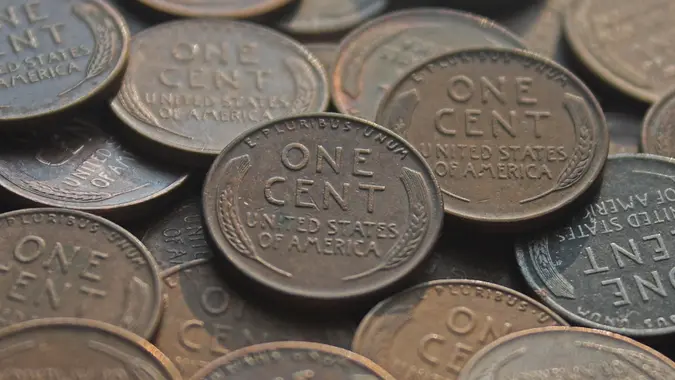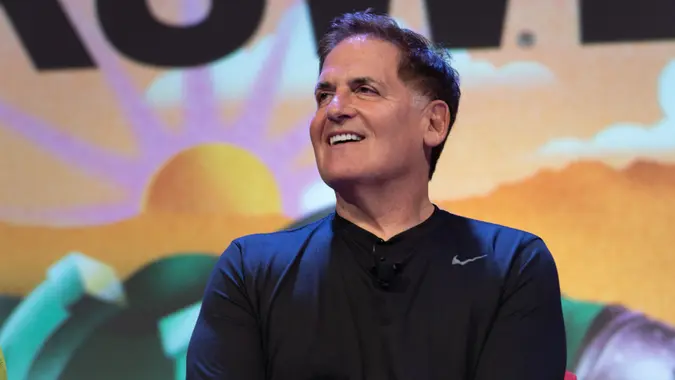Trump Says Voters ‘Did Sign Up for’ Higher Costs — But Are They Here To Stay? Experts Weigh In

Commitment to Our Readers
GOBankingRates' editorial team is committed to bringing you unbiased reviews and information. We use data-driven methodologies to evaluate financial products and services - our reviews and ratings are not influenced by advertisers. You can read more about our editorial guidelines and our products and services review methodology.

20 Years
Helping You Live Richer

Reviewed
by Experts

Trusted by
Millions of Readers
In a recent interview with NBC News, President Donald Trump addressed concerns about rising prices by saying, “Well, [voters] did sign up for it. … This is what I campaigned on.”
His comments highlight a broader question facing American consumers: Are higher costs temporary, or are they the price to be paid for long-term economic gain?
From tariffs and wage dynamics to sinking consumer confidence, experts weighed in on why prices remain high and whether they’re here to stay.
Every Day Items Will Stay Expensive — For Now
Prices for groceries, gas and basic goods remain stubbornly high, and consumers are feeling it.
While inflation has cooled from its 2022 peak, experts said the deeper cost relief could take time due to tariffs, supply chain disruptions and delayed domestic manufacturing gains.
“With inflation already squeezing budgets, everyday consumers face significant financial challenges,” said Michael Podolsky, a consumer advocate and co-founder of PissedConsumer.com.
He explained that many American consumers lack transparency about how tariffs affect the cost of everyday goods, which fuels frustration and changes shopping habits.
Some shoppers, he said, have stopped buying from platforms like Temu, while others are reconsidering Amazon memberships after being surprised by unexpected fees at checkout.
“For households already struggling financially, adapting to these additional costs could take months and further intensify budget pressures,” Podolsky said.
Why It Feels Expensive
On paper, workers are finally getting ahead. In March 2025, inflation stood at 2.4%, while average wages grew by 4.3%, according to USAFacts. This means that real wages, earnings adjusted for inflation, are rising. This trend has continued since early 2024.
Still, prices for essentials remain high. According to the latest Consumer Price Index Summary, prices for everyday items increased by 0.2% since March and by 2.3% since last spring.
Groceries, housing, gas and medical costs continue to weigh on household budgets. Many consumers are still adjusting to a “new normal” of elevated base prices and haven’t rebuilt the savings or stability lost during recent inflation spikes.
These lingering effects may be contributing to declining consumer sentiment. A recent Conference Board survey found that consumer expectations for the future are at a 13-year low.
“Consumer confidence declined for a fifth consecutive month in April, falling to levels not seen since the onset of the COVID[-19] pandemic,” said Stephanie Guichard, senior economist of global indicators at The Conference Board.
So even though wage growth is outpacing inflation, the pressure hasn’t fully eased.
“Wages that don’t increase make rising costs harder to absorb,” said Melanie Musson, a finance expert with Insurance Providers.com. “When the cost of living increases, wages have to increase, or employers can’t recruit and retain employees. As employees are paid more, businesses have to charge more to keep up with wages. It can turn into a vicious cycle.”
Tariffs Drive Costs Higher
From groceries to electronics, tariffs quietly raise prices by increasing the cost of doing business. Consumers are often the ones footing the bill, even when the surcharge isn’t clearly labeled.
“Prices will go up,” said Nik Agharkar, owner and managing member of Crowne Point Tax. “This will be gradual, not immediate, because firms order goods from overseas in bulk.”
He pointed out that the inventory currently available may not reflect tariffs, but incoming goods will likely priced higher.
Despite higher prices, tariffs are unlikely to go away anytime soon, because they’re doing exactly what they were designed to do. In fact, the U.S. government collected a record $16.3 billion in customs dutieslast month, underscoring its financial effectiveness.
What You Can Do
While consumers can’t control tariffs or inflation policy, they can take small steps to stay flexible during this period of uncertainty.
Experts said consumers should focus on budgeting, cutting discretionary spending and being strategic about large purchases, especially as price pressures continue to shift across categories.
“Become more strategic with consumption,” said Chris Motola, the special projects editor and financial analyst at National Business Capital. “This means more utilitarian than status-based purchases, getting more mileage out of the things you already own and taking advantage of loss leaders for groceries.”
Editor’s note on political coverage: GOBankingRates is nonpartisan and strives to cover all aspects of the economy objectively and present balanced reports on politically focused finance stories. You can find more coverage of this topic on GOBankingRates.com.
More From GOBankingRates
Sources
- Today, “Trump says supporters ‘did sign up for’ higher costs.”
- Michael Podolsky, PissedConsumer.com
- USAFacts, “Are wages keeping up with inflation?“
- U.S. Bureau of Labor Statistics, “Consumer Price Index Summary.”
- The Conference Board, “US Consumer Confidence Plunged Again in April.”
- Melanie Musson, Insurance Providers.com
- Nik Agharkar, Crowne Point Tax
- U.S. Department of the Treasury, “Monthly Treasury Statement.”
- Chris Motola, National Business Capital
 Written by
Written by  Edited by
Edited by 

























